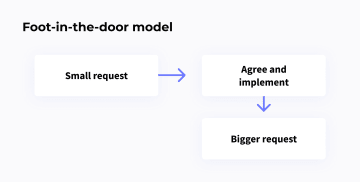Marketing fundamentals
View all articlesYour Funnel Isn't a Survey: The Art of Building Micro-Commitments with Marketing-Psychology

When you picture an online funnel, does your mind immediately jump to a long, multi-page questionnaire? Something that feels more like an interrogation than a journey?
If so, it might be time to shift your perspective. Your funnel isn't a survey.
Surveys are designed to collect data from an already engaged audience. Funnels, especially when fueled by social traffic from platforms like Instagram or TikTok, have a completely different job: converting low-intent traffic into high-quality leads.
Think about it: people scrolling through their social feeds aren't thinking about buying a product or signing up for a service. They're browsing, killing time or looking for inspiration. So, how do you get them from scrolling to moving forward, one tiny, effortless step at a time?
This is where micro-commitments come in. Understanding fundamental human psychology helps to create a journey so natural, so intuitive, that users barely realize they’re progressing from a curious click to a committed conversion.
The Invisible Hand: How Psychology Guides Your Funnel's Momentum
Great funnels don’t start by asking for too much. Instead, they create a sense of momentum by starting small – leveraging micro-commitments to guide users forward. These tiny first steps work so well because they’re rooted in two powerful persuasion principles, as defined by psychologist Dr. Robert Cialdini:
The Consistency Principle: We humans have an almost irresistible urge to be consistent. Once we make a small, initial decision – even just tapping a button – we feel a psychological pull to align our subsequent actions with that first choice. This is the foundation of the "foot-in-the-door" technique.
Takeaway: Get them to say a tiny "yes," and they're far more likely to keep saying "yes."
The Reciprocity Principle: When someone gives us something of value, we naturally want to give something back. If your funnel strategically provides a small piece of value – an insight, a useful fact, a personalized snippet – users are more inclined to return the favor by continuing to engage or sharing their information.
Takeaway: Offer real value first, and users will be much more willing to give you their attention and data in return.

Why This Matters: Your Funnel's Secret Weapon Against Abandonment
Most marketers know friction kills conversions. But the real enemy isn't just friction; it's the feeling of being interrogated or overwhelmed. Long, static forms feel like work, that’s why they see abandonment rates soar above 80%.
By applying micro-commitments and strategic value drops, you flip the script:
Lower the Barrier to Entry: The first step is so inviting, there’s virtually no reason not to engage. You’re not asking for commitment; you’re simply starting a conversation.
Build Unstoppable Momentum: Each tiny "yes" creates a positive feedback loop. Users feel a sense of accomplishment, strengthening their desire to see the process through.
Cultivate Trust & Engagement: When you deliver value mid-funnel, you're not just collecting data; you're building a relationship. This act of giving fosters trust and increases active engagement, making subsequent "asks" feel earned.
The Art of the Micro-Commitment: 5 Psychological Tactics to Implement Today
Ready to turn your funnels into conversion powerhouses? Start here:
Your Opening Act: The Feather-Light First Step.
How-to: Start with the absolute simplest interaction. No name. No email. A single "Yes/No" question, a quick visual selection (e.g., "Are you looking for a job or talent?"), or even just a tap to "Start Quiz."
The Psychology: This is your "foot-in-the-door." The user has now invested minimal effort, triggering the Consistency Principle. They've begun the journey.
Break Down Big Asks into Tiny Chunks.
How-to: Never, ever ask for all their information on one screen. Break down long forms (e.g., name, then email, then phone number) into individual, bite-sized questions across multiple screens. For demographics or budgets, offer ranges instead of demanding precise numbers.
The Psychology: Each single-field screen is a new, easy micro-commitment. It drastically reduces cognitive load, making the overall task feel less demanding and reducing perceived effort.
Strategically Pause to Give Value & Affirm Their Journey.
How-to: After a few questions, share something valuable, something relevant to their previous input. This could be an educational fact, a quick industry insight, or even a personalized tidbit based on their answers so far. Then affirm their input: “Great insight! That aligns perfectly with [snippet]. Let’s continue.”
The Psychology: This activates Reciprocity. By providing genuine value, you create a sense of obligation. The accompanying affirmation validates their effort and the value received, making them feel intelligent and understood, reinforcing their commitment to complete the funnel.
Visualize Progress to Stoke Motivation.
How-to: Implement a clear progress bar or "cookie crumbs" that constantly show users how far they've come and how much is left.
The Psychology: This taps into the "goal gradient effect: people accelerate their efforts as they get closer to completing a task. It subtly leverages the "sunk cost" bias, making users feel more invested in finishing what they've started.
Your Funnel's Next Chapter: From Questionnaire to Conversion Machine
Your funnel isn't just a series of questions; it's a carefully orchestrated conversation designed to build rapport and trust. It MUST be content-first, not question-first. When you design with human psychology in mind—leveraging the power of micro-commitments, strategic value exchange, and well-timed affirmation—you build experiences that feel intuitive, engaging, and genuinely helpful. Users don't feel "sold to"; they feel guided and understood.
That's exactly why we built Heyflow. It's more than just a funnel builder, it's a platform deeply rooted in the science of behavioral science. With Heyflow, you can easily create
Feather-light first steps that draw users in.
One-question-per-page layouts to reduce cognitive load.
Dynamic content blocks to strategically insert educational facts and personalized insights mid-funnel.
Conditional logic to define individual logic paths and a personalized experience.
Calculations to provide individual and personalized results.
Intuitive progress indicators that keep users motivated.
Tools for strategic validation to reinforce user commitment at every crucial turn.
If you’re ready to move beyond static forms and start guiding users with empathy and psychology, it’s time to try Heyflow.
Start building psychology-driven funnels with Heyflow today.



